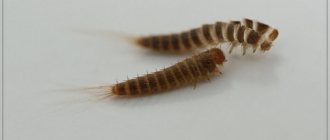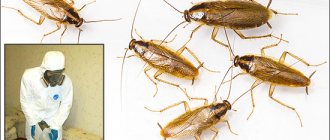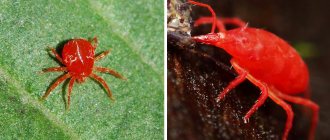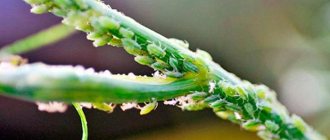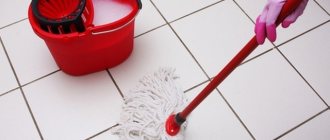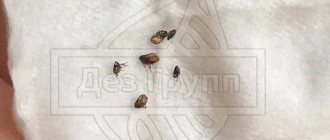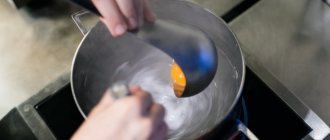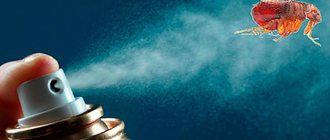Blood-sucking insects, which live mainly on the skin and fur of domestic animals, bring a lot of trouble to humans. Flea bites can lead to allergies, and especially impressionable people simply find it unpleasant to be in an apartment infested with parasites, which is understandable. In addition, in theory, parasites can be carriers of many dangerous infectious diseases, although in practice cases of infection from pests are extremely rare.
Before starting an active fight against fleas, you should determine whether these particular parasites are actually infested in your home, and not, for example, bedbugs or linen lice. That is why you should know how to identify adults (as well as larvae, pupae, eggs) and distinguish them from other common pests.
Adults
The parasites that most insecticides target are adult fleas. An adult insect can reach up to 5 millimeters in size, has a black (these are young fleas) or brown color, and is covered with scales. In the animal's fur, the pest is somewhat reminiscent of a small grain of a plant.
The main difference between fleas and other insects: pests can jump up to thirty centimeters in length, escaping from danger or moving from victim to victim. Sometimes these jumps can be seen with the naked eye. Fleas differ from bed lice in their large size, and from bedbugs in their ability to jump.
Life cycle and reproduction of fleas
Fleas reproduce under certain conditions. The male has testes ending in a genital claw. The female has one or two pairs of ovaries, connecting at the uterus, from which comes the spermatic receptacle. In order for the process of moving seeds into the female’s body to begin, she has to climb onto the male and retract the sex claw into her sperm receptacle. Flea reproduction is a rather complex process. It can last from one week to six months. It depends on how fleas reproduce in a given area.
On a note. Fleas breed on domestic animals at temperatures from 23 to 25 ° C, humidity about 60%. At high temperatures, the larvae and eggs simply dry out. If the air is cold and humid they die. The highest speed at which fleas reproduce is when both of these indicators are high. In this case, the insects are large in size. The flea and pupa can tolerate heat and cold.
Let's look at the stages of flea development step by step:
- The appearance of eggs;
- Larva;
- Pupae;
- Imago.
The appearance of eggs
Flea eggs
This is the first stage of flea development, in which insects reproduce with eggs. After the mating process, the insect is fertilized and is able to lay eggs. Their size is very small. When viewed through a magnifying glass, they resemble grains of rice. If the parasite population is very high, you can see eggs simply falling off the animal's fur.
Flea eggs, due to their small size, can end up on the bed, in the fibers of the carpet, or in genital crevices. Under such conditions, the reproductive process intensifies, the female can lay many eggs, and they are distributed in large quantities throughout the apartment. They can maintain their viability in an unfavorable environment for several weeks. In the insect’s body, the eggs mature one by one, with an average of up to 15 eggs. This happens immediately after feeding. Moreover, this can happen anywhere, even in the fur of an animal. The flea simply shoots the eggs so that they can scatter at a distance from each other. This allows them to not have to fight for food.
Larvae
Flea larvae
In appearance, flea larvae resemble white worms, about 1 mm long. There are fine hairs on their body. The larvae are able to move quickly. They grow, and during the entire stage of their development they molt 3 times and reach a size of up to 6 mm. They can feed on organic materials located near them or on their body. Flea larvae in cats, dogs, and other animals, regardless of who they parasitize, look the same. Therefore, if a person notices them, he will not be able to understand which insect they belong to. If you are interested in knowing what flea larvae look like, you can look at the photos available on the website. You should be aware that larvae do not live on the fur of cats and dogs. Therefore, if their owners find pests in the form of worms, these are not larvae.
On a note. Even the smallest larvae that have just been born have a tooth. It is a solid process with which this parasite breaks through the egg. It falls off during her first molt.
If the larvae have normal food, in sufficient quantity, after a couple of weeks each of them is sealed into a cocoon, from which a flea will subsequently emerge.
Pupae
Flea pupa
At this stage of reproduction, bloodsuckers have a very interesting life cycle. Flea pupae are larvae in a cocoon. The larvae can remain in it for different periods of time, which depends on humidity and temperature. If they are optimal, the parasite from the pupa may appear in a week. Otherwise, the flea pupae will remain in the cocoon for an indefinite period, which can be equal to 12 months. The pupa evaluates the level of humidity and temperature using receptors located on its outer cover. It also senses the carbon dioxide that a cat, dog or other animal exhales. This cat or dog smell is suggested to her by special receptors. That is, the pupa receives a signal saying that it is already possible to leave the cocoon, since food is nearby. According to scientists who studied the life cycle of the flea, this is a real miracle of nature. How pupae can live in a cocoon for so long and what they eat is still unclear. Many people are interested in how to kill a pupa. The fact is that not all chemicals act on them; they are not able to break through the shell. It is impossible to create conditions in the apartment for very high and low temperatures. All that remains is to wait for the time when the pupa leaves the cocoon itself.
Imago
This breeding stage completes the flea's development cycle. As soon as the favorable moment comes, the pupa emerges from the cocoon and looks for a host, catches up, jumps on him, finding a place for herself in the animal’s thick fur.
People are interested in the question of how many eggs a flea lays during the breeding process. The period of her life ranges from one and a half months to two years. Therefore, each individual bears fruit and reproduces differently. The maximum number of eggs she can produce is about 500.
On a note! An adult can live for several months without feeding. But there will be no harm to her health. But due to a period of prolonged hunger, she will not be able to reproduce and lay eggs.
Flea eggs and larvae
Flea eggs (photo below) are very small and difficult to notice with the naked eye. The distribution of eggs ensures a unique process of “laying” them: the female literally “shoots” them with enormous speed. This is why it is rare to find flea eggs on the fur of the pet itself.
Worm-like larvae, which hatch from eggs, often scurry under furry pets' carpets and bedding, behind baseboards and in other hard-to-reach places. Flea larvae are white in color, they are very similar to fly larvae and feed on waste products of adults or small vegetation. They are also very rarely found in the fur of a cat or dog.
How to get rid
Sedentary worms are not difficult to destroy. Even the usual treatment of their habitats with boiling water or a steam generator will destroy all offspring. At any stage of their development, flea eggs cannot tolerate too high or low air temperatures. In winter, bedding and beds for pets can be periodically taken out into the cold. In summer - for drying in places exposed to direct sunlight. The death of the larvae occurs at temperatures of 15 degrees below zero and 45 degrees above zero. The reproduction stage of parasites stops at a temperature of 10 degrees below zero. Therefore, it is advisable to periodically wash and boil bedding, on which fleas prefer to lay eggs.
How to get rid of adults, their eggs, pupae and larvae
The fight against parasites should be comprehensive: carried out in several ways and include repeated treatment of the premises over time, as well as preventive measures. You should not only get rid of annoying insects from your pets, but also disinfect your apartment.
There are several ways to deal with pests that cause discomfort to your cat or dog. Most often used:
- aerosols;
- flea collars;
- detergents (shampoos and soaps);
- drops on the withers.
Flea tablets and injections are also common abroad.
All these remedies are relatively safe for the animals themselves, but have a detrimental effect on parasites: the poison paralyzes the pest, which causes the vital organs and systems of the insects to fail, and the flea dies. There will be no harm to your pet from using such drugs if you choose the right product (according to the animal’s age, breed, state of health, weight) and use it in accordance with the instructions.
The premises are also treated using insecticides or traditional methods. In case of severe infestation, it is more advisable to call a team of specialists to quickly, effectively and safely treat the premises from parasites.
What does a larva look like?
Nymphs or flea larvae in dogs, cats and humans look almost the same - small worms from white to dark in color.
They have a small hard growth on the crown of their head. This is an ovoid tooth that helps the larva break through the egg shell and be born. When the nymph sheds its chitinous cover, the tooth also falls off.
Flea larvae are completely different in appearance from their adult counterparts. Their body has
worm-shaped. They more closely resemble hairy caterpillars, although the hairs can only be seen under a microscope. The length of the larva reaches up to 5 mm. Flea larvae can often be confused with fly maggots, but they are more mobile. At the end of the nymph's body there is a head with jaws of a scraping-gnawing type.
The larvae hide in dark and secluded places in the house. Although they do not have eyes, they are very sensitive to light and instinctively try to hide in the dark. But access to food is also important. Therefore, you can often find them in pet cages, in garbage, under a layer of manure in a chicken coop, in cluttered pantries and closets with grocery supplies.
The larvae do not bite people and do not pose a danger to animals.
They feed on fairly rough food, including plant remains and the excrement of adult fleas. The nymph develops quickly. In a warm environment and in the presence of food, this period lasts up to nine days. If the conditions are not so favorable, then it will remain in the nymph state for up to several months, unless it is discovered and destroyed by humans until then.
If you don’t want to spend money on means to kill cockroaches, then DIY cockroach traps will be an ideal option for you. Have you noticed white worms in cherry fruits? These are cherry fly larvae. How to get rid of it, read this article.
You've probably seen strange insects in the water. You can find out who this is at https://stopvreditel.ru/rastenij/borba/vragi/raznovidnosti-vodyanyx-klopov.html link.
How and with what to fight fleas?
Let's figure it out: what is the most effective remedy for fleas at home? Such methods are usually divided into chemical, public and professional. Chemical methods usually recommend the use of insecticides or chemicals to kill fleas. You can buy them in gels, sprays and traps at any hardware store. This method is the most common due to its many advantages: firstly, its cost is within reasonable limits. The second is the long-term effects of drugs. Thirdly, ease of use. You don't need any knowledge in this area. Folk remedies usually come in the form of herbs and dried flowers, namely wormwood, tansy, calendula and mint. Fleas are very afraid of these odors, so if they encounter them they will immediately die or leave the house. However, this method has many disadvantages: it needs to be prepared first and then boiled or prepared as a solution before application, so it is not for us. Perhaps the easiest way to destroy fleas is to contact the city SES "GigienaDez", which is responsible for professional destruction and disposal of fleas. Specialists use only high-quality insecticides that are safe for humans, so there is nothing to worry about. They also use special professional equipment that has better chemical reactions and contact with parasites, so they can only improve the treatment effect. Before the staff arrives, you need to clean the apartment, that is, wash the floor and put all the food in a sealed plastic container. The only drawback is the cost of the procedure, which is a little expensive, but believe me, the effect of having your apartment treated by a professional will get rid of pests forever.
Basement treatment
If fleas entered the home from the basement, poison them in the apartment and basement. The pest control service will help resolve the issue. In addition, rodents, the main carriers of fleas, are destroyed in the basement.
First, the basement is thoroughly cleaned. All household garbage and rags are taken out of it. The room is swept out and, if possible, a damp cloth is passed along the walls to clean them.
Then they check the pipes that run in the basement to detect leaks. If there are defects, you will need the help of specialists to carry out repairs.
The basement is treated independently with insecticidal agents in the form of aerosols. The advantage of the drugs is their ease of use and good effect. Treatment is carried out daily for five days.
Then they take a break of ten days and repeat the manipulations. If the apartments on the lower floors are heavily infested with parasites, you will need professional help from exterminators. Only after this do they poison the parasites in the apartment.
The entire room is sprayed with insecticides - surfaces, cracks, corners. When leaving the room, you should limit the flow of air by tightly closing doors and windows.
Are they dangerous for humans?
Fleas and their larvae can be carriers of various serious diseases that pose a threat to human life:
- Bubonic plague;
- encephalitis;
- anthrax;
- trypanosomiasis;
- tularemia;
- typhus and relapsing fever, etc.
The likelihood of a threat may not be the norm, but a certain percentage remains. This is the most terrible threat to human health and life.
In addition, if you eat food without washing the eggs with your bare hands, you can become infected with various types of worms.
How do they reproduce?
Despite the fact that fleas reproduce quickly, the process itself is quite complex and requires maintaining certain favorable conditions. The male has testes (2 pieces), ending with genital claws, through which the seed is transmitted to the female. The female has 2 or 4 ovaries, oviducts connecting at the body of the uterus, containing the spermatheca, located at the end of the abdomen in the form of a curved tube.
At the moment of mating, the female climbs onto the male’s back, after which she sucks up the sexually mature organ with the spermatheca. From the testes of a male to the body of a female flea, the seed travels on average about 10–15 minutes. While mating itself can last about a day.
After fertilization, the flea lays eggs in batches (4 to 10 pieces). Since the female needs strength for this, she must be satisfied with food before laying eggs. With normal saturation, a blood-sucking female is capable of laying eggs several times a day.
However, more often females lay one portion per day. Over the entire life cycle of a flea, it is capable of laying 500 eggs, which often infect a pet.
Due to the fact that insects place future offspring on the carrier in advance, subsequently the larvae can easily get enough food and grow quickly. In addition to animal fur, fleas leave clutches in places where they frequent.
The laying process is unique - the female throws eggs from her abdomen over a long distance. It is this method that ensures the vitality of the offspring, since they are at a distance and can eat normally without creating competition for each other.
How to destroy basement fleas in an apartment
To control insects, you must do the following:
- Remove carpets, bedspreads and capes and take them to dry cleaning, or carefully beat them outside.
- Wash the floors, including the baseboards, using a vinegar solution, and then rinse again with detergent.
- Seal floor and window cracks, first treating them with insecticides.
- Treat indoor rooms, floors and walls (1.5 meters from the floor) with special anti-insect preparations.
- Wash bedding and bedding used for animal resting.
- Treat your pets.
Fleas are repelled by odorous plants - eucalyptus, wormwood, tansy and others. Spread the herb around the perimeter of the apartment or prepare a tincture from it. The tincture is used to wipe floors and baseboards. Remember that traditional methods of killing insects are significantly inferior in effectiveness to chemical insecticides.

